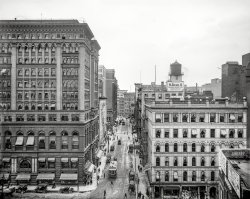
MAY CONTAIN NUTS

Search Shorpy
SHORPY ART

Framed or unframed, desk size to sofa size, printed by us in Arizona and Alabama since 2007. Explore now.
Join and Share
Ad-Free Shorpy
Shorpy is funded by you. Patreon contributors get an ad-free experience.
Learn more.

Recent comments
- Robie House Roof(s)
- There is an interesting novel set here.
- I Was In Berlin
- Pronunciation
- Shell of a Shell
- Never been there but
- BUR-lin
- Hand-made smokes
- Birthplace of Tupperware, or at least its inventor
- Pulp
- Remarkably unchanged in 84 years
- The church is still there ...
- Talk about a smoke show
- Electric Hansom Cab
- I wondered the same thing.
- The location in 2009
- Pill Pusher
- Roll your own
- Rugged and real!
- Civil War history
- Early EV?
- A Charles Purcell - Mama Cass Connection
- Uncle SAAM
- Obfuscation
- One Chocolate Soldier rode away
- Victor Marquis de la Roche
- The Little House Across Way ...
- Vanderbilt Gates
- Vanderbilt Mansion
- You can still see that gate
Member Photos
The Shorpy
Printporium
Printporium
Search Shorpy
Search results -- 30 results per page
- Maison Blanche: 1910
- ...
The Maison Blanche building now houses the Ritz-Carlton Hotel.
"Buffalo Dental Parlors" Must have used really big ... Posted by Dave - 07/19/2012 - 1:01pm -
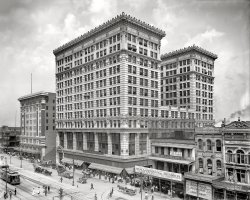
- The Old Post Office: 1907
- ... an arrangement to rebuild it as the Trump International Hotel Washington, D.C.
(The Gallery, D.C., Harris + Ewing) ... Posted by Dave - 08/29/2012 - 2:11pm -
![The Old Post Office: 1907 February 1907. Washington, D.C. "Post Office." This space is now a food court in the Old Post Office Pavilion on Pennsylvania Avenue. In just a few years the P.O. would decamp for a bigger facility near Union Station. View full size.
Detail spottedLove the calendar, "Cape May Real Estate Company"; hard to come by in DC, I'd guess. And those amazing light fixtures seem to have thumb-sized gascocks. Imagine that: a giant room full of paper mail, and hundreds of open flames.
Write your own ghost story.Why does the crowd stare at us as if we interrupted their ritual?
Why is everyone else dissolving?
[They moved during the time exposure]
...and what fills the misshapen human-sized bags?
[Either mail or empty mail sacks. - tterrace]
Good opportunity to stay awayToday the Old Post Office is one of the least pleasant public spaces in Washington. Perhaps it was always so.
Nice Lighting I bet all that natural light made this a much more pleasant place to work than the fluorescently lit modern equivalent. Are those all gas lamp fixtures hanging from the ceiling or electric lights with the bulbs removed? If they are gas lamps, it must have been quite a sight when they were all lit.
What are these?Does anyone know what these two objects are in the photo?
1) Down the middle of the photo, from the top, looks like a long light fixture leading to a large vertical wooden cylinder. What is that cylinder.
[The long structure is the inspectors' gallery. What look like lighting fixtures along the bottom are ports for viewing the area immediately below. The cylindrical structure at the end is the access to the gallery. - tterrace]
2) Hanging from the ceiling are a number of objects that look like large ceiling fans with a rope around the outer rim. A number of them have chains on them, apparently for strengthening. What are these?
De-lighted?There seems to be an abundance of hanging light fixtures in this space (wagon-wheel shaped, with a large central ball, chains and 3-armed fixtures at the "spokes"), but there isn't a single light bulb to be seen! I assume they're electric because many of the "sockets" are seen to be angling downward, and seem to have a switch.
[The "wagon wheel" fixtures are gas jets, superseded or supplemented by the electric mercury-discharge lamps also seen in this view. - Dave]
Goodbye, Panda Express!The tourists will soon have to find another place to stuff their faces.
The food court arrangement was operating at a huge annual loss for the city, so they've recently made an arrangement to rebuild it as the Trump International Hotel Washington, D.C.
(The Gallery, D.C., Harris + Ewing)](https://www.shorpy.com/files/images/SHORPY_15269a.thumbnail.jpg)
- Embaixada do Brasil: 1925
- ... 1920s the house was razed and replaced by the Hay-Adams Hotel. Harris & Ewing Collection glass negative. View full size.
... Posted by Dave - 08/27/2012 - 3:43pm -
![Embaixada do Brasil: 1925 Washington, D.C., 1925. "Brazilian Embassy, Henry Adams House, 1603 H Street N.W." In the late 1920s the house was razed and replaced by the Hay-Adams Hotel. Harris & Ewing Collection glass negative. View full size.
Masterful MasonryAnother superb example of really fine masonry design and execution. Really like the hexagonal pieces above the third floor and the wonderful stonework. Marvelous picture, thanks, Dave!! At least it was 'saved' via this photo!
[If it's any consolation, the driveway and arched entry survived. - Dave]
View Larger Map
Richardsonian Design
Our Beautiful City
...
A handsome residence, to cost about $25,000, will be built by Col. John Hay, at the corner of Sixteen and H streets.
Mr. Henry Adams, son of Charles Francis Adams, will erect an elegant house adjoining it. The plans for both houses were prepared by Mr. Richardson, an architect of Boston.
...
Washington Post, Apr 20, 1884
The Brazilian embassy is now established in the former home of the late Mr. Henry Adams, 1603 H street. The new Ambassador, Mr. Fortura Xavier, formerly Brazilian Minister to England, is now on his way to his new post of duty here.
Washington Post, Sep 7, 1919
Romanesque Revival RecycledParts of the Hay-Adams house were salvaged and incorporated into 2618 31st St. NW and 3014 Woodland Drive NW:
http://www.washingtonhistory.com/ScenesPast/images/SP_1002.pdf
That Henry AdamsAdams had one of Washington's most famous funerary monuments erected in Rock Creek Cemetery in memory of his wife after she committed suicide.
Romanesque Revival RevivalParts of the Adams mansion stonework were reused in 1927 for this house at 2618 31st Street N.W. (photo taken in 1969)
View Larger Map
What else did Richardson design?This building's masonry is drool-crazy gorgeous. I am curious about its colors. Was it red brick, or taupe brick, or yellow brick? And those cutout bird motif tiles--what color were they? If only they had saved those birds and geometrics when they tore it down.
I would have loved to see them as a garden border. I am wondering if the hexagonal elements are true bricks (that go all the way through the wall structure) or tiles on the surface. I am also left wondering what was inside the building. There must have been mantels and doors and fixtures and moldings which we can't see.
Did Richardson design any other buildings this beautiful that did not meet the wrecking ball? Heck, does the guy even have a known first name? Surely his mother didn't call him Mister.
[Click on his name in Stanton Square's post for the Wikipedia entry. Henry Hobson Richardson is the noted architect whose namesake is the Richardsonian Romanesque style of design, of which there are probably hundreds of examples remaining. - Dave]
(The Gallery, D.C., Harris + Ewing)](https://www.shorpy.com/files/images/14508a.thumbnail.jpg)
- American Acropolis: 1918
- ... Estate Exchange , Soldiers' and Sailors' Monument , Hotel Pontchartrain , Wayne County Building , Cadillac Square and the ... with 2 white towers and a clown sign on top), the little hotel building to the right of the Pontchartrain (230 Woodward), the Soldiers ... Posted by Dave - 11/15/2014 - 12:56pm -
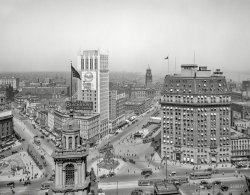
- Dapper 40s Couple
- ...
Ocean View site.. There used to be a very nice hotel and apartment building on that site.. the PINE CREST. By the 1960s it was more of a transient hotel. Torn down in the 1970s. Still a vacant lot at this point.
... Posted by dboynton - 04/06/2013 - 4:19pm -
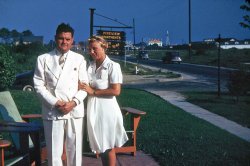
- Stop and Go: 1941
- ... any other requirements could wait until I checked into my hotel room for the night.
Now Banned in Brattleboro Vermont prohibited ... Posted by Dave - 02/14/2019 - 2:43pm -
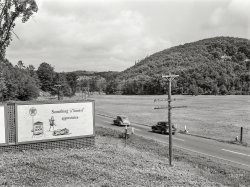
- D.C. Police: 1901
- ... the Old Post Office Building, now the Trump International Hotel.
Local suds Abner-Drury, operating from 1898 to 1938, was a ... Posted by Dave - 04/17/2021 - 10:07pm -
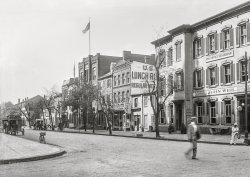
- Elko Tango: 1940
- ... 1935.
Elko seems to like "elks" Elk Hotel, Elk Club, Elk Bar.
Elko is said to have been named by Charles ... Posted by Dave - 01/31/2018 - 10:17pm -
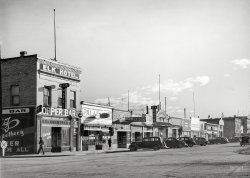
- Star Island House: 1910
- ... Clair Flats, Michigan, circa 1910. "Star Island House." A hotel on the St. Clair River whose scenic arboreal allée, Willow Avenue , ... Posted by Dave - 08/08/2012 - 2:01pm -
![Star Island House: 1910 St. Clair Flats, Michigan, circa 1910. "Star Island House." A hotel on the St. Clair River whose scenic arboreal allée, Willow Avenue, we saw last week. 8x10 inch dry plate glass negative, Detroit Publishing Company. View full size.
Northern hospitalityThey say the St. Clair Flats hotels were popular with Southerners escaping swelter (perhaps looking for a cool-weather counterpart to the Mississippi delta). Whether the lineup on the porch is made up of guests, staff, or some combination thereof, it's the last bunch of folks with whom I'd like to commune with nature.
Those bands on the treesAddressed in this thread.
Your next stop, the Twilight ZoneAnd then all the old people on the porch played Kick the Can, and vanished, as young people.
Hard to FindI was greatly puzzled by this picture and the Willow Ave. picture - where the heck is (or rather was) Star Island? No current maps list Star Island, but I finally found it in an 1895 map from the St. Clair Flats Historical Society. The area is no longer identified as Star Island, and any remnants of the Star Island House and Willow Avenue are long gone.
[See also the maps posted here last week in the comments under the Willow Avenue photo. - Dave]
Good Lord!Charles Addams, please call the office!
(The Gallery, DPC)](https://www.shorpy.com/files/images/4a24386a.thumbnail.jpg)
- Off Broadway: 1942
- ... move around, and DCS does not have to money to buy them hotel rooms, pay their rent or build them houses. I live in a small town in ... Posted by Dave - 06/10/2018 - 1:35pm -
![Off Broadway: 1942 September 1942. "Batavia, New York. Elba Farm Security Administration farm labor camp. An old man who has lived all of his life near Broadway, New York City, and who was taken off relief and sent to the Elba FSA camp to work in the harvest. He said, 'There is so much suffering in the world today that mine doesn't seem so much, and I'm doing my best to help bring in Uncle Sam's crops'." 4x5 nitrate negative by John Collier for the Office of War Information. View full size.
Boo-HooeyTo those among us inclined to lament that Americans today have nothing to complain about compared to this fellow:
1. You are wrong. Homeless kids whose parents are in jail are living in cardboard boxes in the woods behind my Wal-Mart.
2. STOP YOUR WHINING.
ProtectionAfter looking closely at the laces on that right boot, I think he is wearing some sort of shiny (rubber?) waterproof overshoe over his work boots.
Sad Sunday nightHe makes my heart ache.
Waterproof overshoesWaterproof rubber overshoes are called galoshes.
Uncomfortable much?Collier seems to have posed his subject over the crack between two benches.
So much to ask but mostly:I wonder what kind of jokes made this man laugh.
Dapper DanInteresting mixture of clothing -- pinstripe suit coat, possibly bib-overalls and new work boots.
Really AnonTip? You have homeless kids living behind your local Wal Mart? Why have you not reported them to your local state's child welfare division office? We have social programs for that the last I checked to take them in and provide foster homes. So you are wrong about comparisons. Back in the days of this photo, there really WERE homeless kids in the street and no government social safety net to provide for them. Today, we have multi-billion dollar programs to take care of them.
[These kids move around, and DCS does not have to money to buy them hotel rooms, pay their rent or build them houses. I live in a small town in Arizona that has over 300 homeless students. Last year I gave $40 to two boys living in a tent behind the grocery store. Below are some links from my own local newspaper so that you may become better-informed. - Dave]
Link 1.
Link 2.
Link 3.
Link 4.
(The Gallery, Agriculture, John Collier, Portraits)](https://www.shorpy.com/files/images/SHORPY-8c34233a.thumbnail.jpg)
- Longacre Square: 1911
- ... beaches. But alas, after the building of a single small hotel it all came to tears, complete with millions of dollars gone missing, a ... by scaffolding -- a few buildings down from the Rector Hotel?
(The Gallery, Irving Underhill, NYC, Streetcars) ... Posted by Dave - 01/21/2019 - 1:41pm -
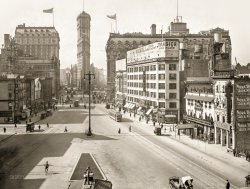
- Market Street: 1907
- ... I can tell, this is the same corner today, now a massive hotel complex. Amazing how much the street has changed. If I have the wrong ... Posted by Dave - 12/19/2012 - 11:42am -
![Market Street: 1907 Continuing our tour of Louisville. "Market Street and Lincoln Savings Bank." Two things to watch out for when crossing the street in Louisville: No. 1, streetcars, and No. 2. Detroit Publishing Company glass negative. View full size.
Same photo, today?As best I can tell, this is the same corner today, now a massive hotel complex. Amazing how much the street has changed. If I have the wrong spot, please correct me!
Mind where you stepThe second lady from the left might be wearing the hem of her skirt almost immodestly high because she is mindful of #2, while also being cautious about #1.
I could almost be convinced that there used to be a television show called "Bullitt". Thos W. Bullitt, esq. occupies the corner office of the top floor.
[You're probably thinking of the 1968 Steve McQueen film. - tterrace]
Yes, that's the thing I almost remembered.
Levy Brothers"Levy Brothers Good Clothes for Men and Boys." The Levy Bros. department store is located 2 blocks down on the left side; shopped there often with my parents in the 50s and 60s. More here.
You Have Been Warned !No, I think the sign on the support wires above is intended for the car operators. This intersection must be known to have problems with pedestrians. If you have to take a hit, do it straight on and roll onto the shelf provided. Be sure to have a nickel handy in case the conductor insists on collecting for the ride.
(The Gallery, DPC, Louisville, Streetcars)](https://www.shorpy.com/files/images/SHORPY_4a22253a.thumbnail.jpg)
- The Light Refreshment: 1957
- ... Camel cigarette billboard, which was mounted on the Hotel Claridge. On calm days, the smoke rings would blow half way across Times ... Posted by Dave - 02/21/2018 - 6:08pm -
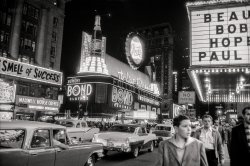
- The Conversation: 1905
- ...
Kittatinny House Kittatinny House was a large resort hotel. Opened on June 20, 1872, it boasted electric lights, elevators, steam ... mountain water in every room, a telegraph office in the hotel and its own orchestra. It was constructed of wood. Yep, in 1931. To ... Posted by Dave - 03/17/2017 - 12:32pm -
![The Conversation: 1905 Circa 1905. "On the grounds of Kittatinny House, Delaware Water Gap, Penn­syl­vania." 8x10 inch glass negative, Detroit Publishing Company. View full size.
It's a gliderFoot board and base are fixed, benches and frame they're on roll back and forth/rise and fall on that curved track visible above the rearmost wheel at the right. Kind of an interesting design but seems like it would be awkward because of the height to the "floor."
Rock and Roll?Trying to determine if the four-seated device rocks, rolls or is tethered.
[Here are a couple examples. -tterrace]
Kittatinny HouseKittatinny House was a large resort hotel. Opened on June 20, 1872, it boasted electric lights, elevators, steam heat, running mountain water in every room, a telegraph office in the hotel and its own orchestra. It was constructed of wood. Yep, in 1931. To the ground.
(The Gallery, DPC)](https://www.shorpy.com/files/images/SHORPY-4a12794a.thumbnail.jpg)
- Pardon My Rack: 1943
- ... Ave. NW, a space now occupied by the Embassy Row Hotel.
[Note floodlamp reflector on the bed. - Dave]
(The Gallery, ... Posted by Dave - 12/11/2016 - 7:38pm -
![Pardon My Rack: 1943 January 1943. Washington, D.C. "Girl in the doorway of her room at a boarding­house." With photographer Esther Bubley (or sister Enid) front and center. Medium format negative for the Office of War Information. View full size.
WW2 WashingtonSpace was at a premium when soldiers and civilians were living in D.C. then, in very tight quarters. It reminds me of the Joel McCrea movie "The More the Merrier".
P.S.I haven't been here for some time. Nice to be back.
Not a hair out of placeThanks jsm, for posting the link to the BYU master's thesis. I love this series of photos. Despite the disorder of their cramped quarters, both young women in this photo have taken care to make sure their hair is beautifully styled. And those 1940s women's hairstyles were very labor-intensive. I notice a leaflet for what are probably night classes at the YMCA. It's January, the men are off at was, so it's no surprise his photo has a more melancholy aspect than others in this series.
The Girl with the Rackappears to be the same one who mistook her wall lamp (sans shade) for an angel, in an earlier Bubley posting. Also, I couldn't help noticing the earmuffs on the bed lower left. I had those as a kid in the '50's, and that spring frame ALWAYS pinched and pulled out a clump of hair. Ouch.
Original ExitSo Kleenex used to exit through the side of the box, eh?
Dissin’s Guest HouseVriean Diether Taggart, the author of a masters' thesis at BYU titled "Documenting the Dissin’s Guest House: Esther Bubley’s Exploration of Jewish American Identity, 1942-43," identifies the woman in the foreground as the photographer's sister Enid. Sisters Enid, Claire and Esther were in Washington together during the war, and one or both of the sisters have appeared in other photos by Esther during that period, including this one, another here and perhaps this one. The boardinghouse was the former mansion of Charles Mather Ffoulke at 2013 Massachusetts Ave. NW, a space now occupied by the Embassy Row Hotel.
[Note floodlamp reflector on the bed. - Dave]
(The Gallery, D.C., Esther Bubley, WW2)](https://www.shorpy.com/files/images/SHORPY-8d33598a.thumbnail.jpg)
- Salumu Aleikum: 1923
- ... from the opposite direction. At right rear you can see the Hotel Continental on North Capitol St.
(The Gallery, D.C., Harris + Ewing) ... Posted by Dave - 06/04/2016 - 4:50pm -
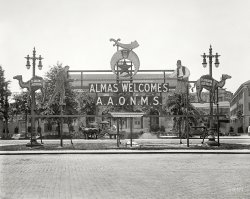
- Divining Mrs. M: 1936
- ... the son of Artur, who was the general manager of the Astor Hotel.
Be it ever so moderne The William and Elizabeth Muschenheim ... Posted by Dave - 10/15/2013 - 4:11pm -
![Divining Mrs. M: 1936 Circa 1936. "Muschenheim, William, Mrs., portrait photograph." Wife of the modernist architect. Nitrate negative by Arnold Genthe. View full size.
House on the DunesA photo presumably taken at William Muschenheim's estate "House on the Dunes," in Hampton Bays, New York. It would have been only a few years old at the time. The real highlight of the estate was its Modernist bath house, which fell victim to a hurricane in 1954. As far as I can tell, the main house itself is no longer standing.
Note: the picture wouldn't have been from the Ann Arbor house seen in another response, as the family didn't move to Michigan until 1950, when William became a professor at the University of Michigan. He retired as a professor in 1972 but remained active in the architectural field until he died in 1990 at age 88.
Venetian BlindsVenetian blinds do not a prison make. By the 50s the slats had gone to slightly down-curved (for stiffness) metal.
The other parts were identical.
[Those aluminum-slat blinds were mostly for office and institutional use. The nicer ones were (and still are) flat and wooden, as in the 1958 house I grew up in. - Dave]
Divined Mrs. Muschenheim was born Elizabeth Bodanzky, daughter of Artur Bodanzky, a conductor of the Metropolitan Opera of New York. William Muschenheim was the son of Artur, who was the general manager of the Astor Hotel.
Be it ever so moderneThe William and Elizabeth Muschenheim house. Ann Arbor, MI
View Larger Map
With earnest supplication,an addition to the pretty girls tag.
(Arnold Genthe, Portraits)](https://www.shorpy.com/files/images/SHORPY_7a02171a1.thumbnail.jpg)
- Family Truckster: 1942
- ... along Miner Street. The building to the left of the hotel is gone; replaced by a corner parking lot -- with a historic marker.
... Posted by Dave - 02/11/2015 - 6:48pm -
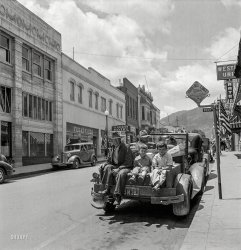
- The Colonnades: 1963
- ... of Saturday Night stay at New York's famous Essex House Hotel."
In 1979, the hotel was the site of musician Donny Hathaway's fatal fall (or leap) from his ... Posted by Dave - 09/19/2016 - 10:12am -
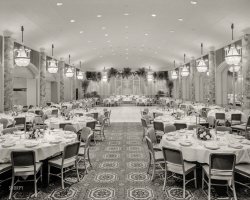
- Red Delicious: 1925
- ... Festival every year. That is the George Washington Hotel in the background. That is where my mother and father met.
(The ... Posted by Dave - 07/05/2012 - 5:35pm -
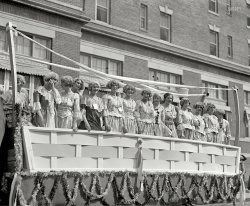
- Union Stockyards: 1941
- ... Jack Benny bragged he was staying at the Stockyards Plaza hotel while his cohorts wasted money staying up town in the Ambassador East or ... Posted by Dave - 02/06/2020 - 12:23pm -
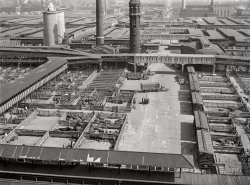
- Gutterball U.: 1910
- ... noticed this place just two doors over from the hotel seen here , and made the connection to Lewis Hine, who took this ... Posted by Dave - 07/28/2018 - 7:48pm -
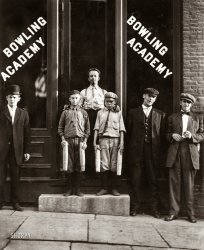
- Wright Light: 1949
- ... my pedestrian past, but enjoy Gottscho's gorgeous shots of hotel lobbies and other exotica.
Comfort? I've seen train cars that are ... Posted by Dave - 01/31/2014 - 2:12pm -
![Wright Light: 1949 May 13, 1949. "Russel Wright, residence and business at 221 E. 48th Street, New York City. Showroom." Gottscho-Schleisner photo. View full size.
Electronic cigarettesAre those hollow tubes in the dish cigarettes?
[Recessed filter tips. - Dave]
Mid-Century ModernDamn, that's some uglee furniture! And the couch gives me a backache just to look at it.
That Folding TableAnybody have an idea how that is supposed to work, and what the fittings on the end are for? Presumably you open it and slide it so the seam is in the middle of the frame, but it would be nice to know for sure.
MooThe furniture may not look too comfortable, but the cowhide chair cushions are a nice touch.
Wright didn't live in this house for much longer. His wife and business partner Mary died in 1952, and he moved with his toddler daughter to his country estate "Manistoga" about 50 miles north of the city.
Frank Lloydwould definitely not approve.
Snappy or snore?I think this is the inverse of that familiar saying, "Youth is wasted on the young." Instead, the inherent beauty of modern design... no matter what "modern" era is depicted... is wasted on those who lived through that era. I've sat in dentists' waiting rooms that looked like this room; and had my parents buy me clothes and shoes in the department stores that Gottscho-Schleisner seemed to shoot so often. Familiarity breeds contempt, I guess, because I yawn at my pedestrian past, but enjoy Gottscho's gorgeous shots of hotel lobbies and other exotica.
Comfort?I've seen train cars that are warmer and more inviting than this.
(The Gallery, Gottscho-Schleisner, NYC, Stores & Markets)](https://www.shorpy.com/files/images/SHORPY_5a15879u.thumbnail.jpg)
- I Want Food
- Children picket at a waiters strike at the Raleigh Hotel in Washington, D.C. From the National Photo Company collection, between ... Posted by Ken - 09/08/2011 - 6:17pm -
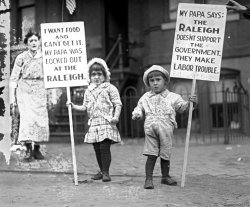
- House of Fleas: 1940
- ...
A different kind of flea house, today. A Super 8 hotel stands there now. There is an old house from the era that still stands, ... Posted by Dave - 01/22/2019 - 3:08pm -
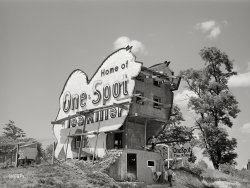
- Engauged: 1942
- ... 1942. "Washington, D.C. Conversion of the Shoreham Hotel furnace from oil to coal burning system." Crank it, boys, and let's see ... Posted by Dave - 01/09/2014 - 5:59pm -
![Engauged: 1942 September 1942. "Washington, D.C. Conversion of the Shoreham Hotel furnace from oil to coal burning system." Crank it, boys, and let's see what this thing'll do. Photo by Howard Liberman for the Office of War Information. View full size.
WartimeOil to coal would seem to be a step back in terms of efficiency. Was this a wartime requirement?
I say Tomato ... what do you say?Dave, quite apart from the picture itself, I was somewhat intrigued by your choice of title, "Engauged." On this side of the pond, a gauge is a gauge. In almost all U.S. usage,I have seen it spelled as "gage." Yet you used "gauge." When is a gauge a gage, (other than a greengage)?
[Standard spelling for the word in America is "gauge." The use of "gage" as a variant spelling (at least among people with college educations) is much less prevalent, probably about equal in popularity with the misspelled variant "guage." - Dave]
Nobody went back to coal from oilMy dad was thrilled to get an oil furnace. No more shovelling, or banking the fire for the night.
[They did during the war. - Dave]
Oil to coal furnaceFrom The Harvard Crimson October 29, 1942:
"In order to save the precious war fuel the University is undertaking a mass conversion from oil furnaces to coal consuming burners. Although the change is not yet complete practically all of the heating units will be made over by November 1.
When the change is made, Harvard will be saving oil at a rate of 87,000 barrels (3,654,000 gallons) a year for the war effort."
Also, this ad from the September 20, 1942 Brooklyn Eagle:
Cellar CockpitAdd a turn and bank indicator and you have the instrument panel of the "Spirit of St. Louis."
GaugesBack then, gauges didn't need units on the faces! That was for sissies! Everybody just knew what they meant.
(Technology, The Gallery, D.C., Howard Liberman)](https://www.shorpy.com/files/images/SHORPY_8d36801u.thumbnail.jpg)
- Ye Old Witch House: 1901
- ... before Prohibition...is ready for you now at every fine hotel, club, drug store, grocer."
Antiques Shop Not very likely to have ... Posted by Dave - 10/25/2012 - 10:37am -
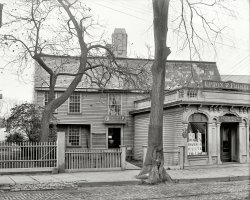
- Detroit Grand Circus Park, approx 1920
- ... Using Google maps and some online history of the Statler Hotel I was able to match the image to Detroit's Grand Circus Park. The next ...
The Statler The photo dates to about 1922-23. The Hotel Statler (left) was completed in 1923. There was another building ... Posted by bhappel - 09/21/2009 - 5:04am -
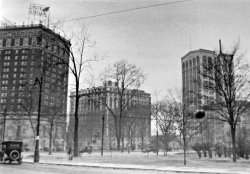
- Fine Arts: 1903
- ... line with its two neighbors on the block: the Auditorium Hotel & Theater (on the left side of the photo) and the Art Institute of ... Posted by Dave - 04/11/2018 - 8:39pm -
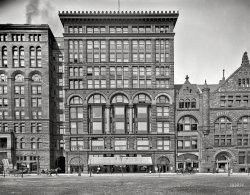
- $5 Teeth: 1910
- ... of Commerce, State and Griswold streets." With the Hotel Richter and B. Siegel department store on State Street in supporting ... Posted by Dave - 02/02/2015 - 1:38pm -
